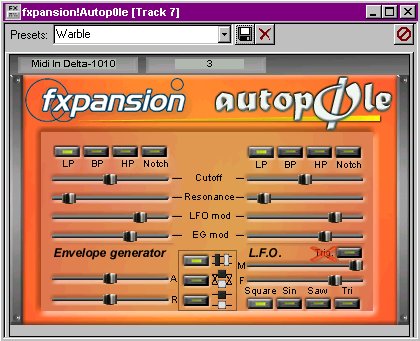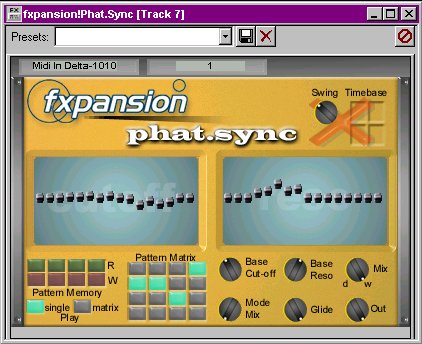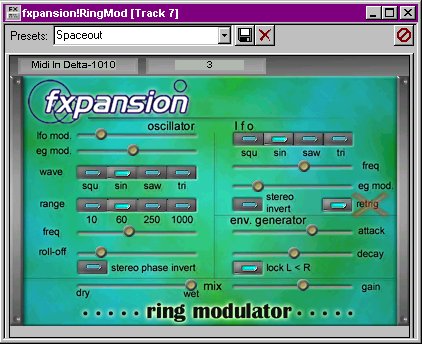PLEASE NOTE: This article has been archived. It first appeared on ProRec.com in November 2000, contributed by then Editor-in-Chief Rip Rowan. We will not be making any updates to the article. Please visit the home page for our latest content. Thank you!
Amulet Audio Software got its start with a popular DirectX plug-in called “VST Adapter” that enabled VST plug-ins to be used in DirectX applications. Amulet has reemerged as Fxpansion and now provides a new suite of plug-ins for DirectX and VST, in addition to an updated version of VST adapter. This new suite is composed of six plug-ins: Autop0le, MidiComb, MTap, PHAT.SYNC, RingMod, and RobotikVocoder. We reviewed the DirectX versions of the plug-ins.
This suite distinguishes itself from other DirectX plug-ins by offering MIDI automation of its controls. This powerful feature enables the DirectX versions to be controlled by external controllers. However, in testing we found that the feature did not live up to expectations in most cases.
Because these plug-ins provide “special effect” processing, their parameters and effects can be hard to describe. I have provided samples of audio clips so that the effects can be better understood.
Autop0le
Autop0le is an envelope- and LFO-controlled filter package. It was the first plug-in of the suite that I tried, and is still my favorite.
Autop0le consists of two separate filters (EQs) that respond to the incoming signal level as well as a low-frequency oscillator (LFO). The filters can be chained together in series, parallel, or can operate independently on left and right channels.
Each filter can be either a low-pass, band-pass, high-pass, or notch filter. Each has its own controls for Cutoff, Resonance, LFO mod, and EG mod. These last controls determine the effect of the LFO and envelope (incoming signal) on the filter set.
What can you do with Autop0le? It is capable of all kinds of cool effects. You can turn off the LFO and use Autop0le as an auto-wah – a cool effect for filtered vocals, keyboards, guitar, or what-have-you. Or you can use just the LFO for all kinds of warbling and sweeping effects. Try putting it on the output of a long reverb with a really low LFO setting and a bandpass filter. The reverb tail will now sweep and sing.

You can use MIDI to drive the Autop0le’s controls, but as we’ll discuss later in this review, there’s some serious latency, so the controls don’t respond well to MIDI. Fortunately, Autop0le works great without MIDI automation!
MIDIComb
MIDIComb is a great idea: use a keyboard to drive a complex comb filter. MIDIComb maps incoming MIDI notes to particular frequencies. This allows you to play chords on a keyboard (or any other MIDI controller) and filter a signal according to the notes you play.

You can use MIDIComb to do predictable effects like vocoding, or design really far-out effects. It’s great to take a drum track and filter it so that the track plays tones. One idea that I tried was to use a MIDI drum track to modulate a noise signal so that the noises were pitched to the drums. There’s a lot of cool stuff to be done with MIDIComb.
The problem with MIDIComb is latency. There’s about a one second delay between the time you play a note on the keyboard until the time the effect changes. And this is when I use the plug-in in Cakewalk Pro Audio 9 with the latency slider set around 20 ms. I’m not sure where the latency is occurring, but it sure makes the thing hard to play.
Nonetheless – it’s still a great idea, and a useful effect!
PHATSync
PhatSync is another cool-as-hell idea: combine a 4-bank, 16-note sequencer with a resonance filter. Huh? OK, follow closely. Start with a resonance filter – a cutoff filter tied to a feedback loop, like a synth. Now, add a 16-note sequencer so that each “step” is a different cutoff / resonance setting. Now add 4 banks for a total of 64 step sequences.
Reaktor users and other tweeker-phreekers are right with me. The rest of you are scratching your heads. I know: I scratched my head at PHATsync for a long time. I actually had to READ the user manual. Three times! In fact, PHATsync is so hard to grasp, a recent review in a popular musician magazine completely missed the mark. The reviewer thought that the sliders were for 16 frequency bands, like an EQ. So did I, at first.

Imagine just one resonance filter. You’d have a frequency cutoff control, and a resonance control. Now imagine that you have a sequencer that will step through 16 of these filters, one after another, in beat with the music.
Are you starting to Get It yet? The only way to “get” PHATsync is to hear what it does to audio. To use PHATsync as a DirectX plugin you have to use a host application that will send MIDI timing data, like Cakewalk or Vegas Pro, and a MIDI tool like Hubi’s or MidiYoke. Hubi’s is available here at ProRec. Without a MIDI loopback tool, PHATsync gets “stuck” on the first filter and never steps through the other 15 filters. Once I got it “steppin’” I was in business. Sadly, though, PHATsync doesn’t lock in tightly to the beat. I suspect the problem is, again, DirectX latency.
RingModulator
The Fxpansion Ring Modulator is definitely best-of-breed. A ring modulator works by using one signal (the “ring”) to modulate another. Ring modulators are useful for creating sweeping, swooshing effects; underwater burbly sounds, and other oddball noises. The Fxpansion Ring Modulator excels in all areas. Ring Modulator is a really spacey, sci-fi type of effect that is perfect for all kinds of advanced music from space rock to electronica.

One of the things I liked best about the Fxpansion Ring Modulator is that it offers many different options for the ring signal – square, sine, triangle, and saw waves. Each imparts its own color on the sound.
Robotik Vocoder
Yet another best-of-breed design. Robotik Vocoder is the classic vocoder design with a few nice features added in.

Using a DirectX vocoder is something of a challenge. To begin with, you have to have the modulator and carrier signals on the left and right tracks of a stereo track. Vocoders work best when used in a “live” setting, so that the person performing the “modulator” signal can work with the “carrier” signal to get the right effect. No such luck in the world of DirectX. I did not get a chance to use the VST version to see if it would work well in a “live” mode.
Some of the advanced features of the Robotik Vocoder include controls to fine-tune the filters. This allows you to tighten up the sound so that the vocoder is more “articulate”.
Of course, everyone knows about using a vocoder to create synthetic-sounding voices. One of the ways I like to use a vocoder is to “morph” two different instruments together.
MTap

MTap is a cool delay plug-in that offers four seperate delays operating on two buses. You can use it as a typical stereo delay, or chain the two buses together in unique and interesting ways.
With MTap’s input bias control you can drive each channel of the delay with either the left or right input or a blend of each. The output of each delay can be filtered and panned. A feedback loop allows you to pan the feedback and then port the output of each delay back into either bus. This combination of panning, filtering, and dual buses provides an array of cool delay sounds far in excess of the average delay unit. MTap also provides a sync tool that lets you set up the delay times by entering the tempo of the song in a Master window, then choosing the delay times by note length.
I really liked using MTap on drum loops. The combination of dual delays and hi- and low-pass filters is great for cool drum loops.
Gripes
One of the coolest things about these plugins turned out also to be a shortcoming, and that is the MIDI automation feature. It’s a great idea, but DirectX is simply not up to the task. The automation available in these Fxpansion plugins is just tantalizingly close… but not quite there. Newer versions of the DirectX specification may include low-latency parametric MIDI control, as found in vSt, but it remains to be seen whether or not the Fxpansion plug-ins will be able to operate properly in that environment.
Another big gripe I have with these plug-ins is that there are no factory presets. I can understand not having presets for an EQ or compressor… but these special effects almost REQUIRE presets in order to be understandable. We hope that Fxpansion will provide a bunch of useful starter presets with the package in its next release.
Finally, the documentation is quite skimpy. There’s nothing to guide the user through using these unfamiliar tools. Again, with an EQ, I usually wouldn’t need a manual… but with PHATsync, I was really in the dark, especially given the lack of presets.
Conclusion
This is a great plug-in package for the engineer who wants something that’s unusual, strange, or downright freaky. With some patience and time, the effects in this package can be used to great and fantastic effect, particularly with techno, dance, drum&bass, and other modern music forms. If you’re in need of some processors that will really warp your mind, give Fxpansion a try.



